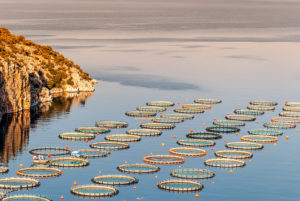James Wright and the Most Asked Aquaculture Question
We asked experts in the aquaculture world the question they’re asked most frequently. During the final few days of National Seafood Month, we’re here to share their questions, and more importantly their answers.
 GAA: What’s the aquaculture question you’re asked the most? How do you answer?
GAA: What’s the aquaculture question you’re asked the most? How do you answer?
First of all, it’s somewhat rare to meet someone – outside of seafood industry events, of course – who understands what aquaculture means. So, beyond the “what the hell is aquaculture?” question, I suppose I’m most often asked why would I support it, and secondly why I would want to write about it all the time. My answer to the first question is fairly easy and it’s sort of a question in return: “Think about all the people on this planet, and how many will soon be here, and then wonder, ‘How are we going to feed everybody?’” The fact is, we need to double the amount of food we produce, in just the next two decades or so. Only the most efficient solutions will help us reach that goal, and aquaculture is one of them. The second question? Well, this industry has a lot going on: technology, innovation, science, investment, environmental stewardship, marketplace dynamics and much more. Most freelance journalists I bring on board can’t wait for their next assignment, so I guess this job isn’t that boring after all!
GAA: Which article are you most proud of in 2018 thus far? Or, which article was most successful? Why?
My visit to the Sogn Aqua halibut farm was amazing. I’d always wanted to go to Norway, and I was not disappointed. But personally, I most enjoyed researching and writing about Urchinomics, a young company based in Norway, headed by a Canadian, using technologies developed in Japan. If that sentence doesn’t scream “global” I don’t know what does. And any headline with “zombie urchins” in it is pretty cool in my world. I love these little creatures and the weird but delicious food they can become, paired with the really amazing environmental service that kelp forests offer the oceans. Brian Tsuyoshi Takeda was a great interview. I also was amused that another person I interviewed for the story, Renee Angwin at San Diego State University, I ended up meeting just a few weeks later at Aquaculture America in Las Vegas. Also, because of growing interest, the Advocate has covered land-based aquaculture extensively, with several pieces about recirculating aquaculture systems and their huge potential to make us rethink where we produce the food we eat.
GAA: How else can we talk about aquaculture? What are synonymous terms that may defuse confusion around the practice and/or unfamiliar term?
Simply, this industry needs to reclaim the words “fish farming.” Own them and everything that comes with them, good and bad. “Fish” is undeniably good, and even people who swear they don’t like fish would most definitely love it if it was prepared by Chef Dave Pasternack. I find that people just need one positive experience with seafood to want to try it more often. “Farming” is also a great word, because farms equal food, and we’d be nowhere without them. But combine the two and there’s suddenly a problem, which I just don’t get. Hey, we’re out of land to increase agricultural output, and yet there’s 70 percent of the world’s surface that’s virtually untapped for farming, so let’s put it to good use. Confusion or distrust about fish farming is virtually always explained by outdated or false information about aquaculture, so let’s replace the negativity by talking more about all the cool things that aquaculture is doing and can do. Aquaculture also needs to own its past – it’s best to admit that aquaculture has indeed stumbled, but then stress that it’s always learning, adapting, evolving, improving. Aquaculture is the world’s fastest-growing food production sector for a reason, and with the right support it can do great things.



